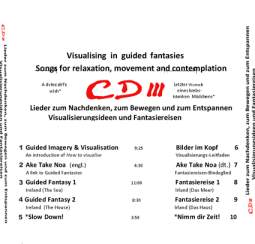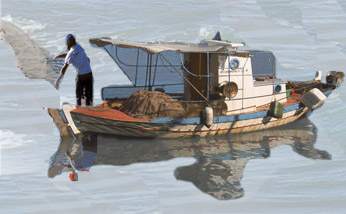CD III - Just a Few General Notes
Karl Preis, Austria
Karl Preis, who used to teach EFL to children and adults in Austria, eventually became involved in TT internationally and, as an animator/facilitator, rather than simply a teacher, has introduced many alternative ideas. (Co-)Author of several teaching materials. Lately, has been arranging and interpreting/translating educational songs and poems. E-mail: karl.preis@reflex.at
Menu
About the CD
“Ake Take Noa“
Here are the ‘actions’
An e-mail worth reading
CD III is one in a series of six that still need a publisher. For pre-recorded copies please contact Karl Preis at the e-mail address above.
 
The CD features both in English and German, an introduction to imaging and visualization, a song for raising the energy in the classroom (physical movement), two guided fantasies and a very special song the details of which you can find below. It is the only bi-lingual CD in my collection of 6 (for the time being).
While for meditation/relaxation any (comfortable) position is possible I suggest lying down: head-spine-legs forming an imaginary (straight) line with arms lying next to your body.
When following guided fantasies your mind may wander off, possibly due to noises from outside or, even, inside. This is quite normal and doesn’t really matter. You can join in again, whenever you are ready... (Something learners need to be aware of - otherwise they might switch off.)
I have used guided fantasies in class as a regular lead-in to lessons for many years: Those eight to ten minutes spent at the beginning have always paid off. And the kids were annoyed, when, for some reason we had to skip the activity.
More (often) than in the past we will need to stop short, switch off, relax, meditate, visualize and, it is very likely that future generations will need it even more than we do… Well, it is the common core of the tracks in CD III. Don’t think about things too much. Just let go, relax and enjoy.
The proof of the pudding is in the eating – so now, after having experimented with visualization (track 1), the song in track 2 lends itself magnificently to seeing (at least) 8 different pictures in your mind’s eye.
Ake Take Noa is a real energy booster (by simply following the actions mentioned in the song (Tai Chi!)) it will be ideal for all those kinaesthetic people among your learners, especially those not so good at visualizing.
The song was chosen to be no.2 on the CD as in my opinion it is a fantastic follow-up to Guided Imagery and Visualization. By listening to the song you can – once more – check how easy it is for you to visualize: The rather strong pictures (sounds, smells) of fishermen singing while doing their work on their nets, rowing their boats, the colours and sounds of the sea, the harbour, the fish market… may well do the trick for many students.
And, of course, Ake Take Noa here acts as a link to the guided fantasies following on tracks 3 and 4 – both featuring the sea.
Set the scene by showing a picture or perhaps, telling a short story: The story is set in a small, picturesque fishing village near the sea. It is late afternoon – the time when fishermen get ready to go out into the sea in their boats carrying their nets down to the harbour.
- Listen to the song, preferably with your eyes closed.
(For the actions see below.)
- Remember, or rather guess, how many actions were mentioned. Take notes and compare them with your neighbours. (While the students are comparing their notes put ‘action cards’ on the floor. Cf. 3.)
- Depending on number of students (11-15) cards – possibly for 2 groups –
representing the actions (drawings, pictures) are spread out on the floor – face down.
(The actions can be split up: In the evening the fishermen shoulder their nets./ They
set off towards the harbour./ They are singing their song. )
- Grab a card. Put the cards in order (from top to bottom).
- Listen again (and establish correct order).
- After collecting the pictures, hand out cards (‘pick a card’) with a/the verb/verb
phrase – in big letters – on them.
- Students arrange themselves standing (in a semi-circle) in the right order, displaying their card so everyone can read them - talking, reading (silently/loudly) all over and over again before listening to the song once more.
- Rearrange (if necessary) – display (hold up) word cards in front of you
and have the whole group say the line that goes with the verb (e.g. sit
= ‘All night long they patiently sit in their boats…’)
- Listen again. Now do the actions and sing along (the refrain): [:Ake take noa:], eo
misso, teo missa, dura missa de.
- Stand in a circle, possibly holding hands. With your eyes closed let the music
reverberate in you for a minute or so.

’Having reached their fishing grounds they cast their nets
– right and left - far into the waters’
In the evening the fishermen shoulder their nets and set off towards the harbour, singing their song.
They board their boats and start rowing out into the vastness of the ocean.
Having reached their fishing grounds they cast their nets – both right and left – far into the waters.
All night long they patiently sit in their boats, gently rocking in the waves.
In the early hours of the morning they haul in their nets - now full of fish.
Back they pull towards the shore again, their boats a lot heavier than on their outward journey.
On arriving in the harbour they carry the heavy fish baskets uphill to the market.
Having sold plenty of fish during the morning they congratulate each other on
having done so well.
A very special song (poem), however, I want to present here is - Slow down!
Vocab necessary for understanding: You will find most words self-explanatory; perhaps (household) chores; haste; sorrow could be pre-taught/introduced.
Dear K, This is one of those "pass on" things but it's nice for three reasons: It looks as though it's genuinely going to help someone, the philosophy is good and I thought you could compose some music around it for one of your songs.
Dear All: PLEASE pass this mail on to everyone you know - even to those you don't know! It is the request of a special girl who will soon leave this world due to cancer. This young girl has 6 months left to live, and as her dying wish, she wanted to send a letter telling everyone to live their life to the fullest, since she never will.
She'll never make it to prom, graduate from high school, or get married and have a family of her own …
Dr. Dennis Shields, Prof. Department of Developmental and Molecular Biology,
Bronx, New York
Slow down!
Have you ever watched kids
On a merry-go-round?
Or listened to the rain
Slapping on the ground?
Ever followed a butterfly’s erratic flight?
Or gazed at the sun into the fading night?
You better slow down
Don’t dance so fast.
Time is short.
The music won't last.
Do you run through each day ‘On the fly’?
When you ask, ‘How are you?’
Do you hear the reply?
When the day is done
Do you lie in your bed
With the next hundred chores
Running through your head?
You’d better slow down...
Ever told your child, “We’ll do it tomorrow”
And in your haste, not see his sorrow?
Ever lost touch,
Let a good friendship die
‘Cause you never had time
To call, and say “Hi”.
You’d better slow down...
When you run so fast to get somewhere
You miss half the fun of getting there
When you worry and hurry through your day
It is like an unopened gift - thrown away.
Life’s not a race
Do take it slower.
Hear the music
Before the song is over…
Reading the girl’s poem I knew I had to put it to music. Music I found in a CD (Farida) of my Viennese friend Robert Janes. and, although the process of producing a CD can be monotonous and strenuous, every playing of the song sent shivers down my spine – for a long time!
I do hope the song touches your heart too and makes you think.
Just what the girl wanted to achieve with her last wish.
Possible activities
As students listen to the song they underline words they like (for whatever reason), long words, words that sound OK/ odd, words they may have forgotten, but have come across before… Do not ask students to underline words they don’t know! They might do so anyway!
By comparing the underlined words with somebody else’s afterwards, meaning might get clear, interesting facts may surface.
Quite obviously you could have discussions about the general content as a follow-up.
I believe this song rounds up CD III beautifully.
Relax and visualize as vividly as you can, and DO TAKE IT SLOWER !!!!

Please check the Creative Methodology for the Classroom course at Pilgrims website.
Please check the Teaching through Music and Visual Art course at Pilgrims website.


|